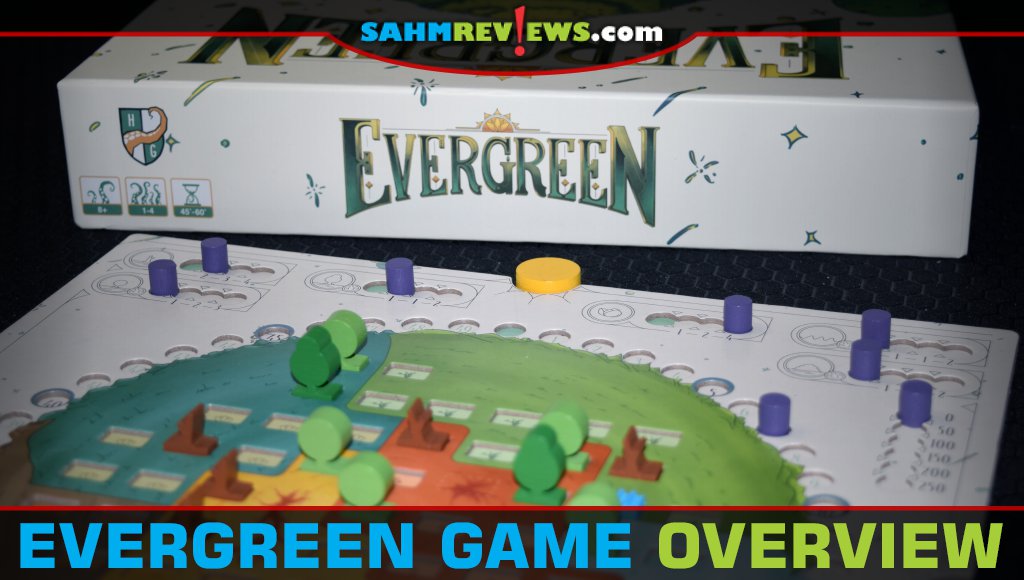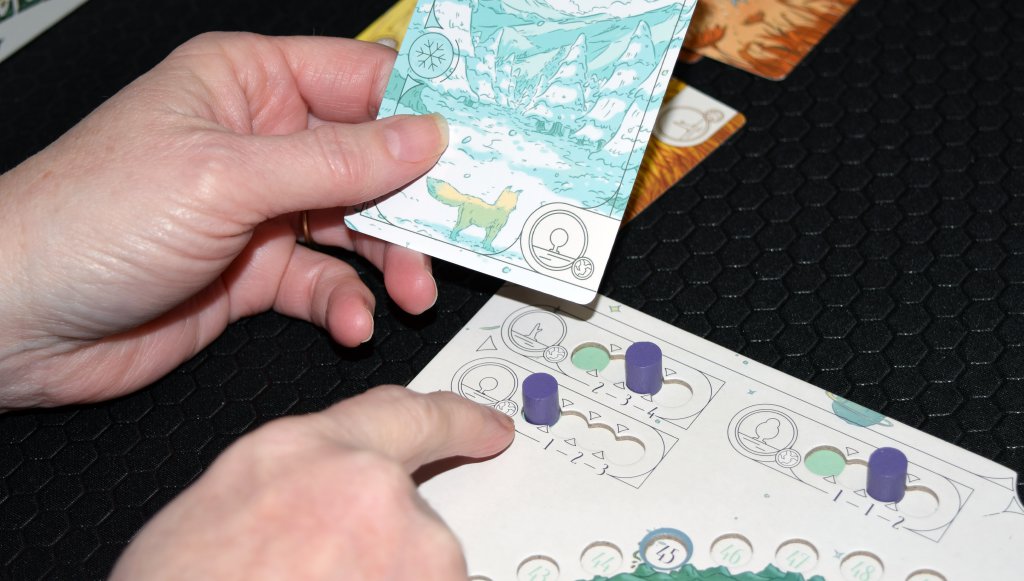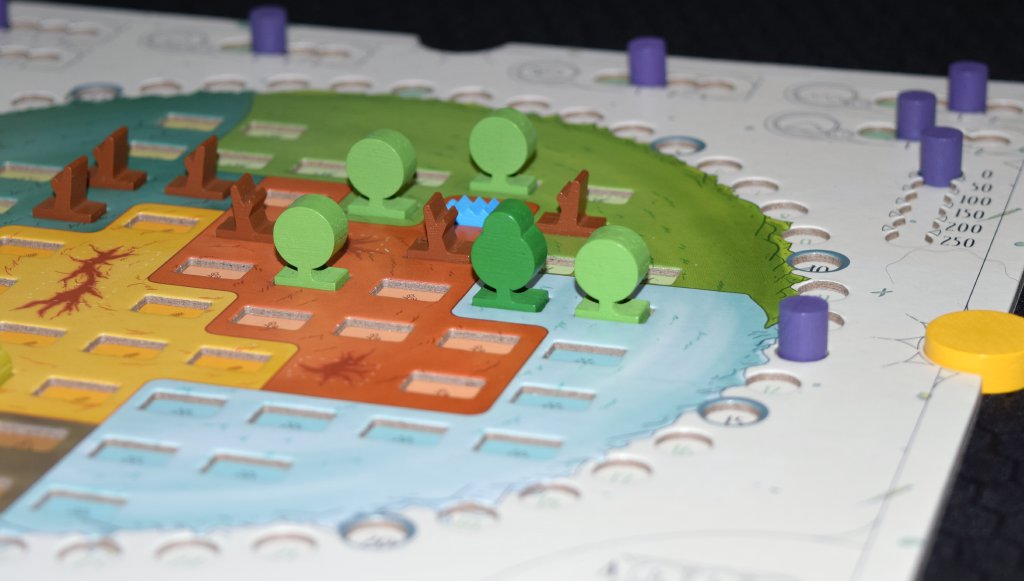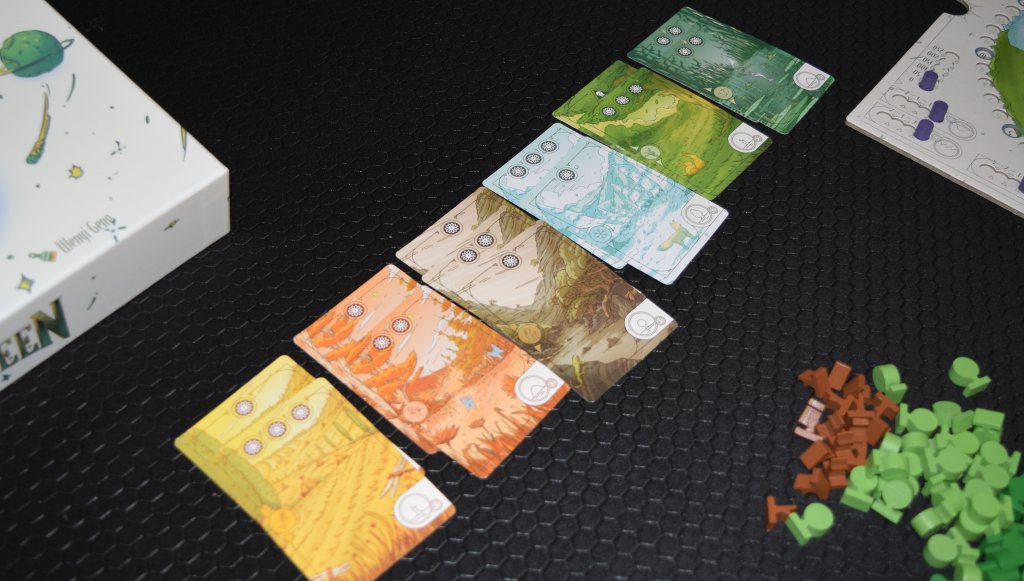Evergreen Board Game Overview

If it seems like we’ve been away for a bit, it’s because we have been. We took some time during the holidays to spend time with family and friends, recharging from the massive amounts of work it took to put together our holiday gift guides and giveaways. We rang in the new year hanging out with a couple dozen local gamer friends, playing games and enjoying snacks everyone brought to share. Most tables focused on four-player games, but there were a couple of breaks including one that allowed the entire group to play a party game together. Among our list of small group games was Evergreen from Horrible Guild, a drafting game about trees. While we haven’t written specifically about Horrible Guild before, we have introduced you to a couple of their games such as Dragon Castle and Potion Explosion.

Each player spends four seasons creating the environment of their own planet by planting seedlings, saplings and bushes, and possibly some lakes. The goal is to have the lushest planet at after four seasons. In addition to a planet board, everyone takes a sun marker and nine cylinder markers. The sun slots into the northernmost divot on the edge of each planet and the cylinders are placed in the top season track (bottom left of the board), scoring tracks (top edge of the land mass and zero on the right side). The remaining six go into the leftmost recessed area in the six bonus areas at the top of the board. Biome cards are shuffled and placed in a face-down deck in the center of the player area. A Fertility Zone is created and those cards (along with others added throughout the game) will be used to determine end-game Biome values.

The game is broken down into four different scoring opportunities (seasons), each with multiple rounds (5 for spring, 4 in summer, 3 in autumn and 2 in winter). At the beginning of each round, Biome cards are revealed and drafted, actions are performed, powers are activated then either another round is started or the season is scored. The drafting pool consists of cards equaling the number of players plus one. Each card depicts three things: 1) The background (and side iconography) identify the region of the planet. 2) The bottom right denotes the power, and 3) across the top there will be up to three fertility stars, a skull icon or nothing. Icons across the top aren’t used during drafting and only come into play for the card that remains after all players have drafted.

The starting player selects one card then places the first player marker on the leftmost card in the row. This gives other players the opportunity to earn the right to select first in the following round. Everyone is working on their own planet, but what you draft (or don’t) may impact what other players are trying to accomplish. When you select a card, you’ll plant seedlings and grow trees based on the biome identified on the card. There are four available actions, the first three taking place in the drafted card’s biome with the last one anywhere on the planet. You may only select ONE action and may not mix and match the options. You may 1) plant three sprouts, 2) grow two existing sprouts or trees one step larger, 3) plant one sprout and grow a different sprout or tree one step or 4) plant one sprout OR have one growth effect. If you happened to grab a wild biome card, you can take any of the actions in any area of the planet.

In addition to an action, each card designates a power that allows you to place additional sprouts, shrubs, lakes, earn points or grow trees. Track the bonuses using the markers at the top of the board. The further to the right each tracker moves, the better the bonus. So while you may want to take a specific region card from the draft row, you also have to look at the powers to select the ones most valuable to you. It’s a balancing act.

Utilizing the sun as your guide for the season, you’ll earn points based on trees that are able to receive some degree of uninterrupted sunlight. So placement and growing of the various pieces of flora isn’t just about growing the most and the tallest. Scoring only takes place at the end of each season, but each row has potential to score multiple points. Unfortunately, if you don’t plan well, when you get to the next season, you may have blocked some of those same trees from scoring from the new sunlight direction. You’ll score points for your largest uninterrupted forest so it’s another layer of scoring to keep in mind.

Finally, let’s talk about the Fertility Zone. The cards not drafted each round impact what lands in that row. Sometimes it will increase the value (more fertility stars), but the Aridity card will actually cancel the most recent card out from the matching biome. At the end of the game, you’ll look at the value in each biome of the Fertility Zone and award that number of points for each of the full grown trees in each section.
Up to four people can play Evergreen, including an option to play solo. There’s a lot of simultaneous play happening so the game doesn’t drag on for a long time. With limited action and power options, all displayed on each player’s board, it’s easy to see what your options are. As a bonus, the recessed boards keep pieces in place which is great for those of us who tend to knock things over. Evergreen has a bit going on, but not so much that it would discourage younger players or someone new to modern games from joining. Order online direct from the publisher or on Amazon, or support local businesses by checking with your neighborhood game store about availability. Horrible Guild is active on multiple social media platforms (like Facebook and Twitter) so be sure to follow them on your favorite to learn more about what else is growing in their catalog of games!
Do you enjoy games with a nature theme?



I truly like nature games if they have beautiful pieces and pictures of the seasons, similar to your game! The sun, moon, stars, & planets can be thrown in there too. After all the are nature. The sun and moon make up earth’s night and day. Plus a gorgeous sky!